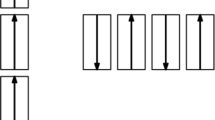Abstract
In this paper we study pipelined nanomagnet logic by simulating and comparing varying adjacent clock line structures. Unlike previous simulations, a realistic clock line shape is used in simulations to obtain a more accurate idea of whether or not these clock lines function properly. First, we simulate individual clock lines using Ansys Maxwell 2D according to the parameters of the fabricated clock lines. Then, these clock lines are placed adjacent to one another to simulate how data can propagate from one clock zone to another. Adjusting the clock line layer structure minimizes a dip in the magnetic field at the clock zone boundaries from 35% minimum below the clocking field to a 16% dip. These magnetic field profiles are then used in the object-oriented micromagnetic framework (OOMMF) to simulate lines of nanomagnets. By reducing the gap between contiguous clock lines, we show error free data propagation in the form of a ferromagnetically coupled line of nanomagnets.







Similar content being viewed by others
References
Rosenberg, R., Edelstein, D.C., Hu, C., Rodbell, K.P.: Copper metalization for high performance silicon technology. Ann. Rev. Mater. Sci. 30, 229–262 (2000)
Nikonov, D., Young, I.: Uniform methodology for benchmarking beyond-cmos logic devices. In: IEEE International Electron Devices Meeting, pp. 25.4.1–25.4.4 (2012)
Lent, C.S., Tougaw, P.D., Porod, W., Bernstein, G.H.: Quantum cellular automata. Nanotechnology 4(1), 49–57 (1993)
Orlov, A.O., Amlani, I., Bernstein, G.H.: at al: Realization of a functional cell for quantum-dot cellular automata. Science 277, 928–930 (1997)
Imre, A., Csaba, G., Ji, L., et al.: Majority logic gate for magnetic quantum-dot cellular automata. Science 311, 205–208 (2006)
Orlov, A., Imre, A., Csaba, G., et al.: Magnetic quantum-dot cellular automate: recent developments and prospects. J. Nanoelectron. Optoelectron. 3, 1–14 (2008)
Kurtz, S., Varga, E., Siddiq, M.J., et al.: Non-majority magnetic logic gates: a review of experiments and future prospects for shape-based logic. J. Phys. Condens. Matter 23(5), 1–13 (2011)
Niemier, M.T., Bernstein, G.H., Csaba, G., et al.: Nanomagnet logic: progress toward system-level integration. J. Phys. Condens. Matter 23, 1–34 (2011)
Alam, M.T., Siddiq, M.A., Bernstein, G.H., et al.: On-chip clocking for nanomagnet logic devices. IEEE Trans. Nanotechnol. 9(3), 348–351 (2010)
Butler, K.: Clock line fabrication and analysis for nanomagnet logic. Masters Thesis, University of Notre Dame (2013)
Siddiq, M. A.: Clock line and field coupled input for nanomagnet logic, Doctoral Dissertation, University of Notre Dame (2013)
Kurtz, S.: Nanomagnet logic: architectures, design, and benchmarking. Doctoral Dissertation, University of Notre Dame (2013)
Chang, A.M., Hallen, H.D., Harriott, L., et al.: Scanning hall probe microscopy. Appl. Phys. Lett. 61(16), 1974–1976 (1992)
Donahue, M. J., Porter, D. G.: OOMMF Users Guide, version 1.0 Inter- agency Report NISTIR 6376 (1996) online: http://math.nist.gov/oommf/
Dingler, A.: Nanomagnet logic: from devices to architecture. Doctoral Dissertation, University of Notre Dame (2013)
Liu, S., Hu, X.S., Nahas, J.J., et al.: Magneticelectrical interface for nanomagnet logic. IEEE Trans. Nanotechnol. 10(4), 757–763 (2011)
Acknowledgments
This material is based upon work supported by the National Science Foundation under Grant No. CCF–1124850.
Author information
Authors and Affiliations
Corresponding author
Rights and permissions
About this article
Cite this article
Butler, K.C., Bernstein, G.H., Csaba, G. et al. Contiguous clock lines for pipelined nanomagnet logic. J Comput Electron 13, 763–768 (2014). https://doi.org/10.1007/s10825-014-0598-4
Published:
Issue Date:
DOI: https://doi.org/10.1007/s10825-014-0598-4




